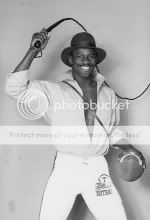Top 25 Players: #4
In the 1980s, the college game never did commit as completely to the forward pass culture as the NFL: the pass interference rule is still less draconian, defensive backs still get away with more, there simply aren’t enough high quality quarterbacks and available practice time to master the true NFL passing offense.
But the rise of the forward pass in the ‘80s did largely kill the alternative approaches. The veer was dead; the option was finished at Oklahoma and Nebraska by 1985. The “three yards in a cloud of dust” offensives of the Big Ten died a hard death. The increasingly athletic, passing Pac-10 routed them in Rose Bowl after Rose Bowl. The pass-crazy WAC produced a shocking 1984 national champion. What offensive innovation that did exist was increasingly from guys like Mouse Davis and LaVell Edwards.
Mack Brown was trying to figure it out too in New Orleans:
#4. Terrence Jones, QB (1985-1988)
 As the nation watched Vince Young run and throw all over the place, and announcers lauded Greg Davis to the sky for the unique, intelligent package given to Young to run, the late 1980s Tulane undergraduate was forced to remark we’d seen all those same plays, those same looks, before. All Brown and Davis had to do was load Tulane game film from 1987, show it to Young, and say “Do that”.
As the nation watched Vince Young run and throw all over the place, and announcers lauded Greg Davis to the sky for the unique, intelligent package given to Young to run, the late 1980s Tulane undergraduate was forced to remark we’d seen all those same plays, those same looks, before. All Brown and Davis had to do was load Tulane game film from 1987, show it to Young, and say “Do that”.Terrence Jones wasn’t the runner Young was. And Tulane’s approach was a bit rawer- as Terrence Jones was really an electric '80s college quarterback experiment, rather than a finished product. Nowadays, we have an idea of how to quantify good quarterback play. But, in the 80s, a lot of it was still exploratory: how much should a quarterback run? how much should you throw on first down? what is the nature of play at this position?
 And the charismatic Jones (the Louisiana Jones and the Dome of Doom football poster is still the best ever) was part and parcel of that argument. As stupid prejudices against African-American quarterbacks declined, the athleticism of the position went up. The successful Jones and Brian Mitchell became prototypes for mobile yet good passers: Andre Ware, Rodney Peete, Brett Favre and Randall Cunningham.
And the charismatic Jones (the Louisiana Jones and the Dome of Doom football poster is still the best ever) was part and parcel of that argument. As stupid prejudices against African-American quarterbacks declined, the athleticism of the position went up. The successful Jones and Brian Mitchell became prototypes for mobile yet good passers: Andre Ware, Rodney Peete, Brett Favre and Randall Cunningham. Jones was darn successful. Introduced to the Green Wave as a running back, he complimented able senior quarterback Ken Karcher. Jones led the team in rushing in 1985 as a freshman as a tailback- and would again in 1988 as the quarterback.
So he was a great rusher (career rushing totals of 1761 yards rushing and 24 TDs), folded into a highly competent passer. Readers here know how I laud the advantages of the 60% passer. Well, Jones managed 60% too- but NOT in a possession, distribution offense.
That meant he could generate cartoon numbers in a time where they were of real value. Despite not being a creature of the C-USA era, Jones is still second all-time in total offense at Tulane, a mere 23 yards behind Shaun King (9468). He left Tulane with almost every school passing record: passing yardage (7,684), passing touchdowns (46), completions (570) and attempts (1,042). He still holds the record for most total yards in a single game: 484 versus TCU in 1986.
Accordingly, Jones finished Tulane ranked sixth in all-time NCAA total offense (just ahead of John Elway)- and was named to some All-America teams in 1988. Thanks to Jones, Tulane had a “good for all of college football” offense, an offense that could generate a 3-1 SEC mark in 1987, real legit goodness. The 1987 LSU-Tulane tilt was the last time the Green Wave took the field with enough major football talent to be "good"- and Jones was the fulcrum: 27-for-40, 316 yards, 3 TDs.
Ultimately, Jones did not have the raw arm to be a franchise NFL quarterback- and his mobility was not prized in the era of big armed NFL prospects like Troy Aikman, Jeff George and Drew Bledsoe. He was drafted late (7th round) by San Diego- but the Chargers wanted him to play defense. But the mobile quarterback was valued in Canada- so he instead played half-a-decade in the CFL with modest success. He then signed briefly with New Orleans as a wide out. It didn’t work out with Jim Mora- and Jones retired.
Labels: Tulane Top 25 Players




<< Home